Overall Expectations
By the end of this course, students will:
- analyse the motion of objects in horizontal, vertical, and inclined planes, and predict and explain the motion with reference to the forces acting on the objects;
- investigate motion in a plane, through experiments or simulations, and analyse and solve problems involving
the forces acting on an object in linear, projectile, and circular motion, with the aid of vectors, graphs, and
free-body diagrams;
- analyse ways in which an understanding of the dynamics of motion relates to the development and use of
technological devices, including terrestrial and space vehicles, and the enhancement of recreational activities
and sports equipment.
Specific Expectations
Understanding Basic Concepts
By the end of this course, students will:
- define and describe the concepts and units related to dynamics (e.g., inertial and non-inertial frames of
reference);
- analyse and predict, in quantitative terms, and explain the linear motion of objects in horizontal, vertical, and
inclined planes;
- analyse and predict, in quantitative terms, and explain the motion of a projectile with respect to the horizontal
and vertical components of its motion;
- analyse and predict, in quantitative terms, and explain uniform circular motion in the horizontal and vertical
planes with reference to the forces involved;
- distinguish between inertial and accelerating (non-inertial) frames of reference, and predict velocity and
acceleration in a variety of situations;
- describe Newton’s law of universal gravitation, apply it quantitatively, and use it to explain planetary and
satellite motion.
Chapters for this unit are 1, 2, & 3
There are essentially three parts to theis unit:
- Velocity and acceleration in one and two dimensions
- Forces and Newton's Laws (Vectors)
- Universal Law of Gravity
- Circular motion and forces that result in circular motion
Kinematics
It is assumed that you can graph, and will alway put units on your numbers.
Problem analysis is a
must. If you refuse to solve problems the way you are shown, then don't ask for help and expect to get a poor mark.
Most of class time will be spent working on problem solving, so be prepared to work in class on given questions.
This section is pretty much a review of grade 11 with some additions.
Terms that you should be familiar with
velocity, acceleration, vector, tangent, slope, displacement
scalar, average velocity, instantaneous velocity,
graphical analysis, acceleration both average and instantaneous
jerk, area under curves.

Here's a sample question that you should be able to do. 

You must be able to work with these equations
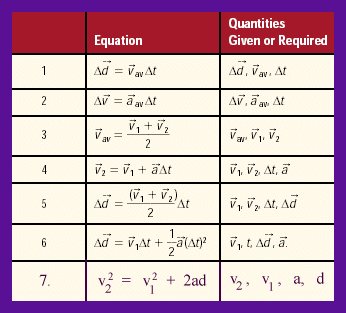
It would be assumed that you can manipulate these equations with ease.
Acceleration in two dimensions would be something that is new, however it is done the same way as velocity in two dimensions is done.
Acceleration due to gravity is based on the number 9.83 m/s
2 [down]. Make sure that you initialize any motion dealing with gravity with a
+ or a
- as required. A lot of times it is your call on the direction.
Working with Vectors: Addition and Resolution
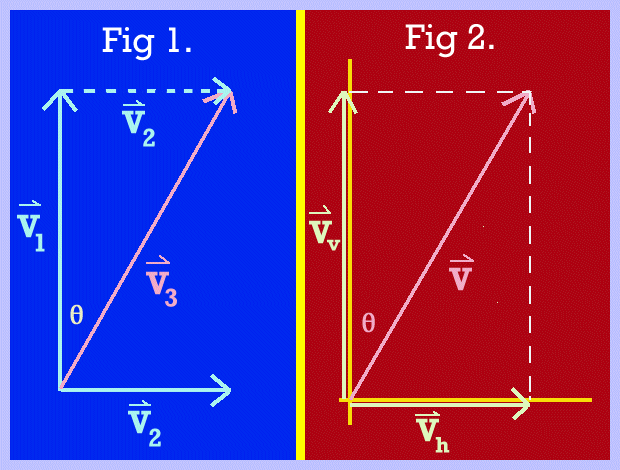
In Fig. 1 two vectors are being added using the head to tail method. You should also realize that Pythagorean theorem could have been used, follwed by sinΘ = O/H and inverse to obtain the angle or direction of the vector.
In Fig. 2 vector resolution is used to break the given vector into its two components on the x, y or horizontal, vertical axis. Using laws of sines and cosines will allow you to calculate the x and y component of the vector.
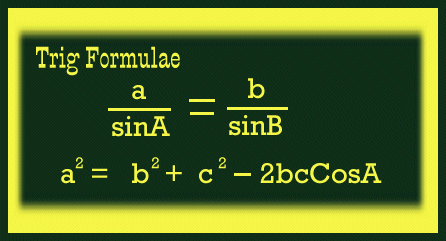
Note: an accurately draw diagram will also eneable you to solve for the required vectors simply by measuring the magnitude (ruler) and angle of direction (protractor).
Can't Remember how to add or subtract vectors, then take a look at a Vector Arithmetic Java Applet

Projectile motion incorporates much of the above concepts into one problem. A "making connections" problem. Vector resolution would be used to solve this type of problem.

Projectile Motion
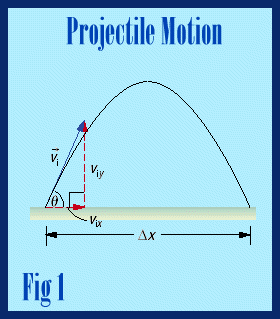 Prjectile motion is based on an object moving in the horizontal and vertical plane at the same time. The problems usually involve an object being propelled into the air at some angle to the horizontal.
Prjectile motion is based on an object moving in the horizontal and vertical plane at the same time. The problems usually involve an object being propelled into the air at some angle to the horizontal.
Ideal projectile motion will follow a parabolic curve or equation. As such a quadratic equation will describe its path. From math the equation will be f(x) = -ax2 + bx + c. You should be familiar with all the properties of this equation. In physics f(x) would be the vertical component of the motion with x being the horixontal component of the motion.
When working with this type of problem an acurate diagram should be considered a must. This is important so that you set your frames of reference accurately. Reading comprehension become extremely important. You will not solve the problem if you cannot imaging the situation being discussed.
Is the vertical velocity positive or negative as the object proceeds upward? It will depend upon how you set up the vectors. See Fig 2
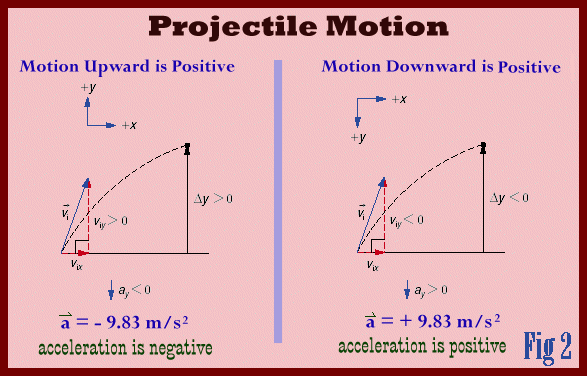
Example: A bowman shoots an arrow into the air. What are the possible situations that arise:
- The arrow goes straight up and then back down again. No horizontal motion.
- The arrow is shot at some angle to the horizontal. I now has both vertical and horizontal motion.
- Is the motion, vertical or horizontal experencing an applied force? If so acceleration will occur.
- The arrow has a initial velocity. Remember that velocity is a vector an as such has a direction attached to it and must be dealt with in the problem.
- Where is the (0,0) point on your accurate diagram or graph?
- Will you solve this problem geometricly or algebraicly? Can you work with the Laws of sines and cosines?
- In order for the arrow to move an applied force must be exerted. Force is a vector in the same direction as the acceleration and velocity unless other forces are applied.
- The force of gravity will dictate the overall motion of the arrow.
- Is the wind blowing? this leads to more complications.
- Where is the bowman standing? On the ground? On top of a cliff?
- How high above the ground is the bowman before the arrow is shot?
- Time can be worked into the problem. How long is the arrow in the air?
- Is the bowman standing still or is he moving? If he is moving then this velocity must be encororated into the problem.
- Is air resistance to be considered?
You must be able to address all of these situations.
Projectile Motion Equations
Basic projectile equations for an object fired at some initial velocity () at an angle from the horizontal over a horizontal surface are:
- dy = height =

- dx = range =

- tr = rise time = tf = fall time =

- flight time, t =

Take a crack at Projectile Motion by trying to Hitting the Target 

Frames of Reference
Frames of reference arise when different observes view the same motion.
Is the observer moving or standing still?
Is the object under investigation moving under the influence of several forces each at a different direction? An aircraft which must deal with prevailing winds.
Is the platform on which the object moving also moving? A simple example of this is a canoe being paddled on a moving river.
When you start pulling the wagon, you notice that the ball ends up in the back of the wagon. Why? There are (at least) two possible lines of reasoning:
- Viewed from beside the wagon: The ball was at rest in the wagon. The ball has inertia, so when the wagon began to accelerate (because you were pulling it), the ball "wants" to stay at rest. The ball ends up in the back of the wagon because the wagon accelerated, and the ball stayed were it was.
- Viewed from inside the wagon (or moving with the wagon): The ball suddenly started rolling toward the back of the wagon. What pushed it? I don't know - "g forces", maybe. What exerted this mysterious "g force" on the ball? I don't know, maybe the acceleration of the wagon exerted the "g force".
Notice that in the first case, Newton's First Law gives a very simple, straightforward explanation. The ball was at rest, it stayed at rest. End of story.
In the second case, life is not so simple. Here, the ball no longer obeys Newton's First Law - it suddenly jumps up and takes off toward the back of the wagon all by itself! No, wait a minute - that can't happen. There has to be some force that pushed the ball - but where did this force come from? You didn't see anything pushing the ball - but something has to be pushing, Oh my! What a mess!
One of the points of this "thought experiment" is that all reference frames are not created equal. In dynamics, some reference frames are clearly easier to use than others, and you need to know the difference. In the first case, your frame of reference is the Earth, which is not accelerating (Ok, see below...). In this frame of reference Newton's First Law works simply and wonderfully. A reference frame that is not accelerating is
called an inertial reference frame - because the Law of Inertia works there.
On the other hand, when you were moving with the wagon, you were viewing the motion from an accelerating reference frame (often called a non-inertial reference frame). In this reference frame, Newton's First Law does not seem to work, since the ball seems to "take off" toward the back of the wagon all by itself. Since people seem to have a deeply-ingrained belief that balls don't "just take off by themselves", they tend to believe that there must be a force acting on the ball to cause this behavior - the "g force". This, however, leads to even more problems and muddled thinking - what exerts this mysterious "g force"?
The easy answer is - There is no force! Certainly, no force was necessary to explain the (same) motion in situation 1 - and a force is either there, or it isn't. You can't have a force when you look at a situation in one way, and no force when you look at the same situation in another way! This "g force" is an example of a fictitious force - there is actually no force! Fictitious forces tend to appear when you are viewing a motion from an accelerating reference frame.
An additional note of Frames of Reference 
 On page 62 under Chapter 1 Summary here is the diagram for Make a Summary
On page 62 under Chapter 1 Summary here is the diagram for Make a Summary 

Dynamics: Forces in Action
In this section we wish to look at several different forces.
A simple example to look at is an object resting on a horizontal surface
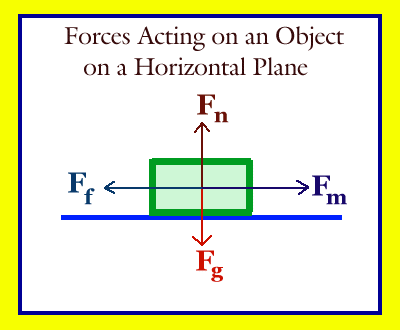 In this diagram
In this diagram
- Fm = any applied force which may or may not cause the object to move
- Fg = is the force of gravity downward equal to the mass x 9.83 m/s2
- Fn = is called the normal force, it is what hold the object up or on the surface. It is the reaction force to Fg and is always perpendicular to the surface.
- Ff = is the force of friction acting between the object ant the surface it is on and is always a reaction force to Fm.
Ff may or may not be equal to Fm but can never be less than Fm. Why?
Contact Forces and a free body diagram
Here is an example...

In this diagram, there are many forces acting. Can you draw a free body
diagram for each mass ? Try it

The above shows what the free body diagrams look like for each mass.
All the forces have a symbol or name that is familiar except for the
forces labelled Fm1 and
Fm2.
These forces represent the force that exists because of m1 pushing
on m2, and by Newton's 3rd Law, of m2
pushing back on m1. This is a contact force that
is actually a Normal Force because it is acting normal to
the surface of the block... if these blocks were moving across
each other, then the friction one would calculate would depend on
these normal forces, not the ones between the table and the boxes.
- Normal Force Note

- Tension Note

- Static Friction Note

- Kinetic Friction Note

Friction on an Inclined Plane

Forces acting on an object on an inclined plane are shown in Fig 3. Identification of forces as follows:
Fg : is the force of gravity acting on the object; the object's weight, units are in Newtons (N)
Fn : is the normal force perpendicular to the surface of the inclined plane; has a magnitude of cos Fg
Ff : is the force of friction opposite to the motion of the object
Fm: is the resultant force causing the motion of the object parallel to the inclined plane and is caused by gravity; has the magnitude of sin Fg
Angle θ : is the angle of the inclined plane
The net force of motion on the object is the sum of Fm + Ff. Remember that these two forces act in opposite directions and numerically are subtracted. The overall or net force is NOT shown in Fig 3 because it depends upon the magnitude of the other forces.
Friction occurs when a body slides across a surface and is a reactionary force, that is, it opposes the applied force and acts in the opposite direction of the motion. Three situations do arise and are list below:
When Ff is greater than Fm the object is at rest. The force of friction is great enough to prevent the object from sliding down the plane.
When Ff equals Fm the object is just of the verge of moving. In this situation Fm is called the limiting static friction (page 97 text book).
When Ff is less than Fm the object is moving down the inclined plane and the force Ff that opposes this motion is called kinetic friction.
On an inclined plane gravity is the force that causes the object to move (unless there is an external applied force). Because of the angular inclination of the plane resolution of forces can be applied to Fg. On resolution, some of Fg will be equivalent to Fn and the rest will become Fm, the force of motion. Projecting Fg onto the Fn line (see diagram Fig 3.), Fn has a value of cos Fg and Fm has a value of sin Fg.
As you can see the smaller the value of the greater the value of Fn and the less value of Fm. The greater the angle the greater Fm and the greater the probability that the object will slide down the ramp.
Coefficient of Friction
The coefficient of friction whether kinetic or static is the ratio of the frictional force Ff to the normal force Fn. A graph of force of friction versus normal force will yield a straight line with a slope equivalent to coefficient of friction. Kinetic friction is equivalent to (but in the opposite direction) the force needed to keep body moving at a constant speed.
Static friction is the force needed to start an object moving and is greater than the kinetic force.
Coefficients of friction are a function of the two surfaces that are in contact with each other. A table of such values is found on page 98.
Usually the math problems are straight forward and use the coefficient of friction equation found on page 98 of the text. The interesting problem occurs when used with the inclined plane where Fn has to be evaluated using either a geometric diagram or a trig expression and the mass of the body sitting on the inclined plane.

Uniform Circular Motion
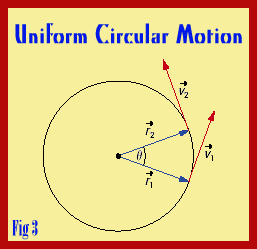
Uniform circular motion is actually a specific type of motion. An object is undergoing uniform circular motion if it is traveling at a constant speed while moving in a circle. For example, if you drive a car around a circle while maintaining a constant speed, you are performing uniform circular motion.
The main requirements for uniform circular motion are
- a constant speed
- motion in a circle.
The object has to move in a circle and not some other shape. If the object is moving at a constant speed but is not moving in a circle, then it is not uniform circular motion.
Velocity also includes a direction in addition to the speed. This makes all the difference in the world. While an object undergoing uniform circular motion is moving at a constant speed, it is not moving at a constant velocity. This is because the direction of its motion continues to change as it moves around the circle. And, because the direction is always changing, its velocity is not constant.
Remember, a constant velocity only occurs if both the object's speed and its direction are constant. The only way this can occur is if the object is moving in a straight line and at a constant speed.
In the picture below, the blue dot is moving at a constant speed around a circle. In other words, the blue dot is undergoing uniform circular motion. Notice that while the speed is constant, the direction continues to change as the blue dot moves around the circle. In the figure below, the direction of the velocity (at any given point on the circle) is denoted by the red arrow.
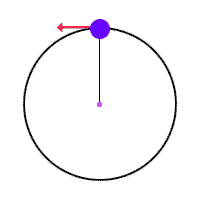
Newton's 1st Law of Motion tells us that, whenever an object's velocity is changing, there must be some external net force acting on the object to cause this change in velocity. Another way to think about this is to think of acceleration. Since the velocity of an object undergoing uniform circular motion is changing, it must be accelerating. This is because acceleration is defined as the change in velocity over time. Therefore, whenever an object's velocity is changing, it is experiencing an acceleration. According to Newton's 2nd Law of Motion, this acceleration must be caused by some external net force, once again, leading to the conclusion that an object undergoing uniform circular motion must be experiencing an external net force.
Putting all these points together, we find that
- an object undergoing uniform circular motion has a velocity that is not constant. The velocity is not constant (even though the speed is constant) because the direction of the velocity continues to change as the object moves around the circle.
- Because the object's velocity is changing, we know the object is experiencing an acceleration as it moves around the circle.
- An object can only experience an acceleration when there is an external net force acting on the object because it is the external net force which causes an object to accelerate. In other words, when we see an object undergoing uniform circular motion, we know there must be some force acting on that object which is responsible for making the object move around a circle at a constant speed.
Main Conclusions
- In general, if we want to increase the speed with which the object undergoes uniform circular motion (while keeping the radius unchanged), we need to increase the amount of force pulling inward on the object.
Next, we showed how the above formula tells us exactly how much to change the amount of force in order to make the object's speed increase. In particular, the amount of force (required to make an object undergo uniform circular motion) is related to the object's speed by the factor below.
Fc is related to the speed, v, by the following term: v2
- In general, if the radius of the circle, around which the object undergoes uniform circular motion, is increased (while keeping the object's speed unchanged), the amount of force required to make the object undergo uniform circular motion (around the new circle with the larger radius) is decreased.
Next, we showed how the above formula tells us exactly how much the amount of force changes as the radius of the circle changes. In particular, the amount of force (required to make an object undergo uniform circular motion) is related to the radius of the circle by the factor below.
Fc is related to the radius of the circle by the following factor: 1/r
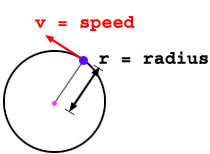 While the focus of this section was on uniform circular motion, we did something else of equal importance which will be useful in other sections as well. In this section, we looked at the formula we were given and, in a sense, "tore it apart". We investigated how the amount of force depends on various factors in the formula, namely the speed and radius. In addition, we saw that this information could be readily obtained by just looking at the formula and focusing on the relationship between the amount of force and the other factors: the speed and radius.
While the focus of this section was on uniform circular motion, we did something else of equal importance which will be useful in other sections as well. In this section, we looked at the formula we were given and, in a sense, "tore it apart". We investigated how the amount of force depends on various factors in the formula, namely the speed and radius. In addition, we saw that this information could be readily obtained by just looking at the formula and focusing on the relationship between the amount of force and the other factors: the speed and radius.
For instance, we studied the relationship between the amount of force and the object's speed by isolating the factor in the formula that depends solely on the speed. After doing so, we looked at how a change in speed changes the required amount of force, while keeping all other properties, like the mass, unchanged.
If an object is travelling in a circular path at constant speed its velocity is changing because, even though the magnitude of the velocity remains constant, the direction of the velocity is changing continuously.
The velocity vector points along a tangent to the circle, in the direction that the object would tend to move if it were suddenly released.
The acceleration acts in the same direction as the change in velocity.
The acceleration is called centripetal acceleration. It always acts inward, toward the centre of the circle, in the same direction as the change in velocity, perpendicular to the velocity vector.
The magnitude of the centripetal acceleration is given by:



where R is the radius of the circle, T is the period of revolution, f is the frequency of revolution, and ac is the magnitude of the centripetal acceleration.
The subscript c serves as a reminder of the vector nature of the acceleration. Its direction is constantly changing at every position along the circular path.
From Newton's Second Law:  The force acts in the same direction as the acceleration. The force, directed towards the centre of the circle,
The force acts in the same direction as the acceleration. The force, directed towards the centre of the circle,
is called centripetal force. 
For an extra look at Centripetal Forces

For a complete note on
Circular Motion (See lessons 1 & 2) 
Here's a summary from the Physics Classroom on Circular Motion.
To summarize, an object moving in uniform circular motion is moving around the perimeter of the circle with a constant speed. While the speed of the object is constant, its velocity is changing. Velocity, being a vector, has a constant magnitude but a changing direction. The direction is always directed tangent to the circle and as the object turns the circle, the tangent line is always pointing in a new direction. As we proceed through this unit, we will see that these same principles will have a similar extension to noncircular motion.
*****************
Any object moving in a circle (or along a circular path) experiences a centripetal force; that is there must be some physical force pushing or pulling the object towards the center of the circle. This is the centripetal force requirement. The word "centripetal" is merely an adjective used to describe the direction of the force. We are not introducing a new type of force but rather describing the direction of the net force acting upon the object which moves in the circle. Whatever the object, if it moves in a circle, there is some force acting upon it to cause it to deviate from its straight-line path, accelerate inwards and move along a circular path. Three such examples of centripetal force are shown below.
******************
To summarize, an object in uniform circular motion experiences an inward net force. This inward force is sometimes referred to as a centripetal force, where "centripetal" describes its direction. Without this centripetal force, an object could never alter its direction. The fact that the centripetal force is directed perpendicular to the tangential velocity means that the force can alter the direction of the object's velocity vector without altering its magnitude.
**********************
Applying the concept of a centripetal force requirement, we know that the net force acting upon the object is directed inwards. Since the car is positioned on the left side of the circle, the net force is directed rightward. An analysis of the situation would reveal that there are three forces acting upon the object - the force of gravity (acting downwards), the normal force of the pavement (acting upwards), and the force of friction (acting inwards or rightwards). It is the friction force which supplies the centripetal force requirement for the car to move in a horizontal circle. Without friction, the car would turn its wheels but would not move in a circle (as is the case on an icy surface). This analysis leads to the free-body diagram shown at the right. Observe that each force is represented by a vector arrow which points in the specific direction which the force acts; also notice that each force is labeled according to type (Ffrict, Fnorm, and Fgrav). Such an analysis is the first step of any problem involving Newton's second law and a circular motion.
*******************
Sample Problem #1
A 900-kg car makes a 180-degree turn with a speed of 10.0 m/s. The radius of the circle through which the car is turning is 25.0 m. Determine the force of friction and the coefficient of friction acting upon the car.
Sample Problem #2
The coefficient of friction acting upon a 900-kg car is 0.850. The car is making a 180-degree turn around a curve with a radius of 35.0 m. Determine the maximum speed with which the car can make the turn.
For a solution to these two sample problems  and scroll down to find the solutions
and scroll down to find the solutions

Gravitation and the Universal Law of Gravitation
Now that we've seen what the force of gravity depends on, let me introduce the formula.
Newton's Law of Universal Gravitation can be expressed as:
 where F is the attractive force between m1 and m2 (in N), m1 and m2 are the masses in kg, and d is the distance between the masses, in metres.
The value of , the gravitational constant, can be expressed as:
6.67 x 10-11 Nm2/kg2.
where F is the attractive force between m1 and m2 (in N), m1 and m2 are the masses in kg, and d is the distance between the masses, in metres.
The value of , the gravitational constant, can be expressed as:
6.67 x 10-11 Nm2/kg2.
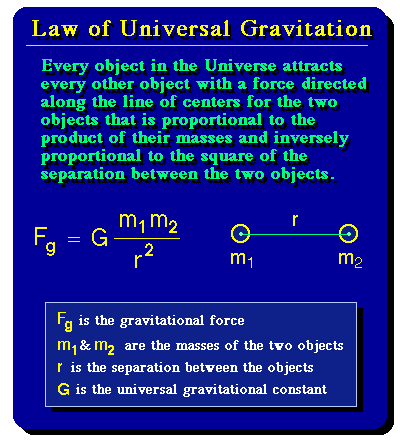
The weight of an object of mass m at the surface of the Earth is obtained by multiplying the mass m by the acceleration due to gravity, g, at the surface of the Earth. The acceleration due to gravity is approximately the product of the universal gravitational constant G and the mass of the Earth M, divided by the radius of the Earth, r, squared. (We assume the Earth to be spherical and neglect the radius of the object relative to the radius of the Earth in this discussion.) The measured gravitational acceleration at the Earth's surface is found to be about 983 cm/second/second.
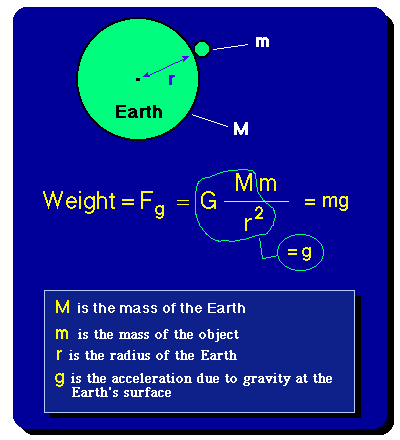
More information of the The Value of G


Planetary and Satillite Motion: In Three Parts
You may consider the follow either your note or required readings. These note will be discussed in class. It will be ssumed that you have read them.
It may seem like a lot so you may want ot summarize them yourself.
The best part of these notes are the questions asked at the end of each note. Make sure you can answer these questions.
There will be carry over into the next unit from these ideas.
- Circular Motion Principles for Satellites

- Mathematics of Satellite Motion

- Energy Relations for Satellites

If you have questions ask them!

























 The force acts in the same direction as the acceleration. The force, directed towards the centre of the circle,
The force acts in the same direction as the acceleration. The force, directed towards the centre of the circle,
 where F is the attractive force between m1 and m2 (in N), m1 and m2 are the masses in kg, and d is the distance between the masses, in metres.
The value of , the gravitational constant, can be expressed as:
6.67 x 10-11 Nm2/kg2.
where F is the attractive force between m1 and m2 (in N), m1 and m2 are the masses in kg, and d is the distance between the masses, in metres.
The value of , the gravitational constant, can be expressed as:
6.67 x 10-11 Nm2/kg2.

